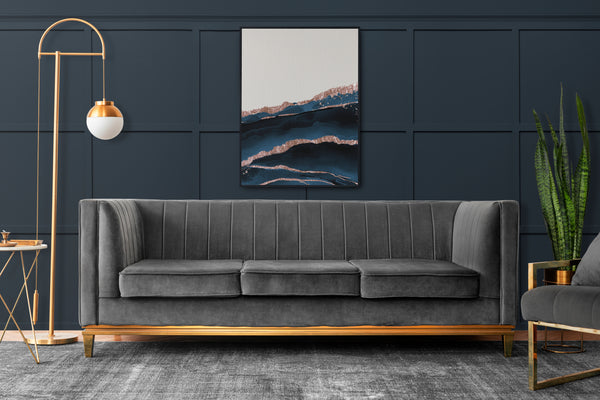How Do You Restore Leather Furniture? - Learn Tips And Tricks

Leather furniture is super popular and is not surprising. This classy material oozes both modern and contemporary vibes and makes a space feel more high-end. Though this comes with a hefty price tag, people anyway go for it because it ages like fine wine over time. So, it is often viewed as an investment.
Leather is soft, breathable, and adjusts to your body temperature, so it can provide you ample comfort all year round. And let's not forget durability. Likewise, we can literally keep writing about the perks of leather furniture.
But let's face the elephant in the room. Leather is made from animal skin, and so, like all other skin layers, leather tends to crack open if not maintained properly. You can't simply thrash it. Why spend a fortune replacing leather furniture when you can restore it at a fraction of the cost?
We know that you wonder if restoring the leather furniture is a big hassle. But the reality is otherwise. This blog teaches you some DIY on how to restore leather furniture.
Now let's learn about them.
Importance Of Restoring Leather Furniture

Restoring leather isn't just an option but a golden rule to elongate its lifespan. While leather is durable, it tends to crack or fade with time. Restoring it helps revive its strength and flexibility and makes it last years longer.
- If you favor sustainability, restoration is a great idea. Because it reduces waste and saves resources. You give them a second life and are kinder to our Mother Earth.
- Worn-out leather can become stiff or rough. But restoring it restores its softness and comfort, especially for furniture.
- Last but not least, restoring leather is all about getting the most out of what you already own while keeping it more stylish and sustainable.
Steps To Follow To Restore The Damaged Leather Furniture?
1. Cleaning The Leather Furniture Is The Golden Rule Of Thumb

The first step in leather restoration is cleaning the leather properly. Because leather is susceptible to being exposed to sunlight, oil, rain, & dust.
So, it's best to clean it regularly. If you are cleaning the leather, it is always better to use the manufacturer-recommended cleaning products to clean and maintain the leather furniture properly based on the instructions.
Also, when exposed to sudden stains or dirt, it is better to identify the same prior and carry out the necessary cleaning process. Some of the most common ways of cleaning the leather furniture upholstery are using a microfiber cloth along with diluted white vinegar and drying the leather with a clean, dry towel.
2. Restore The Cracked Leather
Leather is a natural material, and the lack of love and care in terms of maintenance can make it dry and eventually crack open.
Though it's not entirely possible to restore cracked leather in all cases because somehow the crack will always be there. But it can be hidden using a good leather conditioner.
We will address three different ways in which leather cracks can be handled.
Method 1: Rehydrate Leather With A Conditioner

- Start with wiping the leather using a microfiber cloth with the cleaner added. Try rubbing along the leather's grain to avoid deepening the cracks.
- Instead of a commercial cleaner, you can mix together 1 part of mild soap with 8 parts distilled water. Use baby soap or a liquid dish or hand soap too. The goal is to clean the leather before treating it.
- Once the leather dries, the cracks start to show. Now use a strong leather conditioner on the cracks and smooth out these areas.
- Continue scrubbing along the grain, and the leather will become a more consistent color, hiding the cracks.
- Next, leave it to rest for 2 hours (or the manufacturer's recommended drying time) until it feels dry to the touch.
- Based on the conditioner, treat the leather multiple times. Spread more conditioner and scrub it across the cracks and again leave it to dry.
Continue treating the leather until the cracks are gone.
Method 2: Seal The Cracks With A Leather Filler

- Use a leather cleaner or mild soap to wash off the grime from the leather. After wiping off the dirt and debris, leave it to dry completely.
- Take a 600-grit superfine sandpaper to smooth the cracks until you can find it soft and smooth to the touch. Next, wipe the dust using a dry microfiber cloth.
- Next, spread a leather filler (looks like paste) over the cracks using a palette knife. Keep applying extra paste until the cracks are filled. And finally remove the excess paste with the knife's edge.
- Leave the leather to dry for at least 6 hours. If it's left open, it tends to dry faster. Direct sunlight or extreme heat can run the risk of drying out the leather and can worsen the crack.
- Plus, remember that the filler tends to shrink when it dries. So, you should apply a second layer and spread more filler.
Method 3: Blend Cracks With A Leather Dye

- Start with sanding the cracks with 600-grit sandpaper and clean the leather using a microfiber cloth.
- Spread a thin coat of leather dye that matches your leather using a sponge or applicator pad.
- Next, use a hairdryer on high for 2 minutes to set the dye. Next, you should apply at least 2 to 5 coats of dye while focusing on blending it into the cracks.
- Now, finally use a leather sealer on a sponge to protect the dyed area.
- Finally, to cure the sealer, use a hairdryer for 2 minutes and finish the repair.
- By carefully following the steps, you are left with leather that looks smooth, fresh, and ready to use.
You can also use filler (optional). Go for a colorless leather filler to hide deep cracks for a smoother finish.
Note: It isn’t possible to restore cracked leather in all cases, and at times the only solution is to replace the leather. But there are ways to prevent the occurrence of such cracks. A general thumb rule is to never allow the leather material to dry up. Proper cleaning and moisturizing will ensure that the crack development is prevented.
If the leather cracks are beyond repair, there are professionals who can help with the restoration of the cracks by adding patches or fillers. Superglues and leather patches can be used to treat leather fabrics.
3. Leather Conditioning Is A Unique Cleaning Requirement

While cleaning the leather furniture is the usual norm, like any other furniture, there's something unique about the material. Conditioning the leather is highly important to maintain the texture as well as prevent the leather from releasing any toxic odor.
Because, as you know, with time and external factors, the leather can become dull. To bring back that rich, smooth look and vibrant color and to make it act as a barrier against dirt, moisture, and wear, a leather conditioner is a must.
To condition the leather, take a soft or lint-free cloth and add the conditioner to the cloth and wipe it evenly on the leather. Let the conditioner sit for a day or for at least 24 hours. Then, finally, after the leather dries, use a cloth and wipe off the excess conditioner found on the surface.
Some commonly available things for leather conditioning include rubbing alcohol, baking soda, and lemon juice.
4. How To Restore Water-Damaged Leather?
Let's be honest upfront. Restoring water-damaged leather is not a piece of cake, but still it's doable with the right techniques.
- First things first, don't panic and use a hairdryer or put it straight in direct sunlight. This can make things worse, like the leather will dry it too much or warp it. So, let the leather air dry naturally.
- Next, wipe the leather down using a soft, damp cloth to clean the accumulated dirt. But too drenched in the leather because it's already water-soaked or damaged by water.
- The next important step is to condition it. Since leather loses its natural oils when it gets wet. To bring back the shiny part, a good leather conditioner will do.
- Wait until the conditioner gets fixed on the leather as expected and wipe off the excess.
5. Refinishing Worn Leather
Leather repair compounds can be used for restoring worn-out leather up to a certain extent. These compounds can be applied as layers until the satisfied refinishing has appeared.
After which, commercially available leather colorants can be used to dye or restore the colors of the leather. Again, rather than applying colors to the damaged spot alone, it is advisable to apply the same throughout the leather so that the desired color and finish are obtained uniformly.
Do’s And Don'ts To Remember While Restoring Leather Furniture
- Using water or any other low-viscous liquids (liquids that flow easily, anything that is too wet or oily) is not generally advised to be used on leather products. It is advisable to use dry products for cleaning and maintenance, which include some leather creams or shoe polish.
- If something too oily has spilled on the leather, applying baking soda and allowing the place to dry for a while would be a good solution before applying any conditioner.
- Preventing extreme conditions of temperature, moisture, and humidity on leather can increase the lifespan and reduce the frequency of maintenance.
- It is better to keep pets away from leather because they can leave marks or scratches.
- If you think that maintenance is hard or if it can't be done by yourself, it is always advisable to take it up to a proper professional leather care expert.
Final Words
Leather is a common, versatile material that's predominantly loved by furniture buyers. Leather is durable, but over time, it has a tendency to crack, fade, or dry out. So any other material requires proper cleaning and restoration to increase its durability.
Leather restoration is a process to prevent or reduce the occurrence of dryness on leather surfaces by using certain techniques. With a bit of effort, trust us, you can save your favorite pieces and keep them looking great for years to come.





